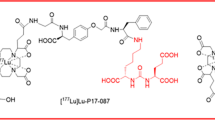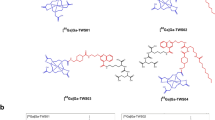Abstract
Purpose
Surgical resection is the standard treatment for localized colorectal cancer, which is the most common type of gastrointestinal cancer. However, over 40 % cases are diagnosed metastasized and apparently inoperable. Systemic chemotherapy provides an alternative to these patients. This study aims to evaluate the therapeutic potential of liposomal doxorubicin (lipoDox) in combination with liposomal vinorelbine (lipoVNB) in a CT-26 colon carcinoma-bearing mouse model.
Procedures
The in vitro cytotoxicity of Dox and VNB on CT-26 cancer cells was determined by MTT and colony formation assays. Mice were subcutaneously inoculated with 2 × 105 of CT-26 cells in the right hind flank. When tumor size reached 200 ± 50 mm3, mice were assigned to receive different treatment protocols. The pharmacokinetics, micro single-photon emission computed tomography/x-ray computed tomography imaging, biodistribution, and immunohistochemical staining studies were performed to survey the therapeutic efficacy of each regimen.
Results
Based on the results of pharmacokinetic study, co-administration of lipoDox and lipoVNB did not affect their individual systemic distribution, while lipoDox retained longer in blood than lipoVNB did. Superior tumor growth retardation was observed in the group received lipoDox plus lipoVNB administration (1 mg/kg each, namely D1V1) than those injected with lipoDox plus VNB (1 mg/kg each, namely D1fV1). No severe side effects were detected in each group. The tumor-to-muscle ratio (T/M) derived from 3′-dexoy-3′-[18F]fluorothymidine ([18F]FLT) micro positron emission tomography (PET) images of D1V1- and D1fV1-treated mice and the controls on day 7 was 6.88 ± 0.54, 7.50 ± 0.84, and 9.87 ± 0.73, respectively, suggesting that D1V1 is a more efficacious regimen against CT-26 xenografts. The results of proliferating cell nuclear antigen (PCNA) immunohistochemical staining were consistent with those findings obtained from [18F]FLT microPET imaging.
Conclusion
This study demonstrated that lipoDox in combination with lipoVNB was more efficacious than clinically used regimen, lipoDox plus VNB, in the treatment of colon carcinoma and [18F]FLT-PET is a promising approach in monitoring the treatment outcome at early stage.







Similar content being viewed by others
References
Cunningham D, Atkin W, Lenz HJ, et al. (2010) Colorectal cancer. Lancet 375:1030–1047
Watson AJ, Collins PD (2011) Colon cancer: a civilization disorder. Dig Dis 29:222–228
Koo SL, Wen JH, Hillmer A, et al. (2013) Current and emerging surveillance strategies to expand the window of opportunity for curative treatment after surgery in colorectal cancer. Expert Rev Anticancer Ther 13:439–450
Ballinger AB, Anggiansah C (2007) Colorectal cancer. BMJ 335:715–718
Tewey KM, Rowe TC, Yang L, et al. (1984) Adriamycin-induced DNA damage mediated by mammalian DNA topoisomerase II. Science 226:466–468
Swift LP, Rephaeli A, Nudelman A, et al. (2006) Doxorubicin-DNA adducts induce a non-topoisomerase II-mediated form of cell death. Cancer Res 66:4863–4871
Toso C, Lindley C (1995) Vinorelbine: a novel vinca alkaloid. Am J Health Syst Pharm 52:1287–1304 quizz 1340-1281
Gonzalez-Cid M, Cuello MT, Larripa I (1997) Mitotic arrest and anaphase aberrations induced by vinorelbine in hamster cells in vitro. Anti-Cancer Drugs 8:529–532
Goa KL, Faulds D (1994) Vinorelbine. A review of its pharmacological properties and clinical use in cancer chemotherapy. Drugs Aging 5:200–234
Carrato A, Rosell R, Camps C, et al. (1997) Modified weekly regimen with vinorelbine as a single agent in unresectable non-small cell lung cancer. Lung Cancer 17:261–269
Gebbia V, Maiello E, Testa A, et al. (1996) Single agent vinorelbine in the treatment of unresectable lung metastases from colorectal cancer. Oncol Rep 3:563–565
Klotz DM, Nelson SA, Kroboth K, et al. (2012) The microtubule poison vinorelbine kills cells independently of mitotic arrest and targets cells lacking the APC tumour suppressor more effectively. J Cell Sci 125:887–895
Love RR, Leventhal H, Easterling DV, Nerenz DR (1989) Side effects and emotional distress during cancer chemotherapy. Cancer 63:604–612
Gabizon A, Martin F (1997) Polyethylene glycol-coated (pegylated) liposomal doxorubicin. Rationale for use in solid tumours. Drugs 54(Suppl 4):15–21
Vici P, Colucci G, Giotta F, et al. (2011) A multicenter prospective phase II randomized trial of epirubicin/vinorelbine versus pegylated liposomal doxorubicin/vinorelbine as first-line treatment in advanced breast cancer. A GOIM study. J Exp Clin Cancer Res 30:39
Drummond DC, Noble CO, Guo Z, et al. (2009) Improved pharmacokinetics and efficacy of a highly stable nanoliposomal vinorelbine. J Pharmacol Exptl Ther 328:321–330
Kenny LM, Vigushin DM, Al-Nahhas A, et al. (2005) Quantification of cellular proliferation in tumor and normal tissues of patients with breast cancer by [18F]fluorothymidine-positron emission tomography imaging: evaluation of analytical methods. Cancer Res 65:10104–10112
Rasey JS, Grierson JR, Wiens LW, et al. (2002) Validation of FLT uptake as a measure of thymidine kinase-1 activity in A549 carcinoma cells. J Nucl Med 43:1210–1217
Seitz U, Wagner M, Neumaier B, et al. (2002) Evaluation of pyrimidine metabolising enzymes and in vitro uptake of 3′-[18F]fluoro-3′-deoxythymidine ([18F]FLT) in pancreatic cancer cell lines. Eur J Nucl Med Mol Imaging 29:1174–1181
Lee WC, Chang CH, Ho CL, et al. (2011) Early detection of tumor response by FLT/microPET imaging in a C26 murine colon carcinoma solid tumor animal model. J Biomed Biotechnol 2011:535902
Wu CY, Chou LS, Chan PC, et al. (2013) Monitoring tumor response with radiolabeled nucleoside analogs in a hepatoma-bearing mouse model early after Doxisome® treatment. Mol Imaging Biol 15:326–335
Kim DW, Ahn DS, Oh YH, et al. (2006) A new class of SN2 reactions catalyzed by protic solvents: facile fluorination for isotopic labeling of diagnostic molecules. J Am Chem Soc 128:16394–16397
Lin YY, Li JJ, Chang CH, et al. (2009) Evaluation of pharmacokinetics of 111In-labeled VNB-PEGylated liposomes after intraperitoneal and intravenous administration in a tumor/ascites mouse model. Cancer Biother Radiopharmac 24:453–460
Cattel L, Passera R, Katsaros D, et al. (2006) Pegylated liposomal doxorubicin and vinorelbine in recurrent ovarian carcinoma: a pharmacokinetic study on alternate administration sequences. Anticancer Res 26:745–750
Gwak G, Kim JY, Park K, et al. (2011) Comparison of doxorubicin plus docetaxel neoadjuvant chemotherapy with doxorubicin plus vinorelbine in primary breast cancer. J Breast Cancer 14:129–134
Jaffray M, Buchbinder N, Lutun A, et al. (2015) Salvage therapy with gemcitabine, vinorelbine, and pegylated liposomal doxorubicin for relapsed or refractory pediatric Hodgkin lymphoma. Results of a retrospective series of four children. Ann Hematol 94:1401–1406
Lo YL (2000) Phospholipids as multidrug resistance modulators of the transport of epirubicin in human intestinal epithelial Caco-2 cell layers and everted gut sacs of rats. Biochem Pharmacol 60:1381–1390
Abra RM, Bosworth ME, Hunt CA (1980) Liposome disposition in vivo: effects of pre-dosing with lipsomes. Res Commun Chem Pathol Pharmacol 29:349–360
Kao YJ, Juliano RL (1981) Interactions of liposomes with the reticuloendothelial system. Effects of reticuloendothelial blockade on the clearance of large unilamellar vesicles. Biochim Biophys Acta 677:453–461
Proffitt RT, Williams LE, Presant CA, et al. (1983) Liposomal blockade of the reticuloendothelial system: improved tumor imaging with small unilamellar vesicles. Science 220:502–505
Been LB, Suurmeijer AJ, Cobben DC, et al. (2004) [18F]FLT-PET in oncology: current status and opportunities. Eur J Nucl Med Mol Imaging 31:1659–1672
McKinley ET, Ayers GD, Smith RA, et al. (2013) Limits of [18F]-FLT PET as a biomarker of proliferation in oncology. PLoS One 8:e58938
Hsieh CH, Chen YF, Chen FD, et al. (2005) Evaluation of pharmacokinetics of 4-borono-2-18F-fluoro-L-phenylalanine for boron neutron capture therapy in a glioma-bearing rat model with hyperosmolar blood-brain barrier disruption. J Nucl Med 46:1858–1865
Wang HE, Liao AH, Deng WP, et al. (2004) Evaluation of 4-borono-2-18F-fluoro-L-phenylalanine-fructose as a probe for boron neutron capture therapy in a glioma-bearing rat model. J Nucl Med 45:302–308
Acknowledgments
The authors thank the financial support from Cheng Hsin General Hospital, Taiwan (CY10401); Department of Health, Taipei City Government, Taiwan (10301-62-010); and China Medical University, Taichung, Taiwan (CMU-104-N-08). The authors also appreciate the technical support from the Molecular and Genetic Imaging Core, Taiwan Mouse Clinic, which is funded by the National Research Program for Biopharmaceuticals (NRPB) at the Ministry of Science and Technology (MOST) of Taiwan.
Author information
Authors and Affiliations
Corresponding authors
Ethics declarations
Conflict of Interest
The authors declare that they have no conflict of interest.
Electronic supplementary material
ESM 1
(PDF 310 kb)
Rights and permissions
About this article
Cite this article
Wu, CY., Tang, JH., Chan, PC. et al. Monitoring Tumor Response after Liposomal Doxorubicin in Combination with Liposomal Vinorelbine Treatment Using 3′-Deoxy-3′-[18F]Fluorothymidine PET. Mol Imaging Biol 19, 408–420 (2017). https://doi.org/10.1007/s11307-016-1005-2
Published:
Issue Date:
DOI: https://doi.org/10.1007/s11307-016-1005-2




